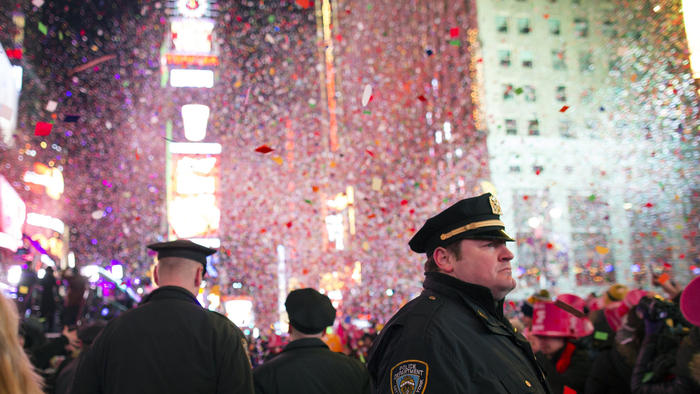A few weeks ago, as New Yorkers (well, tourists) rang in the New Year at Times Square, an unusual thing happened: no one got arrested. Since late December, low-level arrests in the city dropped by over 60%, citations for traffic violations fell by 94%, and summonses have been down by 90%. These extraordinary events were part of a virtual work stoppage or ‘slowdown’ of police activity conducted by the NYPD.

New York City police officers in Times Square, Jan. 1, 2015. (Craig Ruttle, AP). Source: Chicago Tribune
Tensions have been growing between New York’s largest police union, the Patrolmen’s Benevolent Association, and Mayor Bill de Blasio, who the union blames for the shooting deaths of two officers on December 20, 2014. This slowdown also comes in the midst of national protests that have adopted the slogan “black lives matter” following the killing of three unarmed black men, Michael Brown, Eric Garner and Ezell Ford, by police officers. In response to the “anti-police” sentiment garnered by protests and comments made by Mayor de Blasio on police brutality, the NYPD stopped issuing fines in New York and claimed they would only make arrests that were “absolutely necessary”.
This of course raises a few questions: What arrests are deemed “necessary”? Why are they happening in the first place?
Low-level summonses were among the arrests that dropped the most, which include “quality of life infractions” such as noise violations, loitering, acts of vandalism and public drinking.
These quality of life infractions are part of a wider police tactic known as “broken windows policing”, wherein low-level offenses, such as vandalism, are considered precursors to larger crimes and are thus heavily punishable by law. It is a controversial tactic, that has been championed by New York Police Commissioner William Bratton, but has little evidence to prove its effectiveness. In reality, ‘broken windows’ has led to the over-policing and criminalization of low-income communities and communities of color. According to the New York Daily News, 81% of the 7.3 million people summoned for quality of life crimes between 2000 and 2013, were Black and Latino. At its extreme, this police technique can also be attributed to the murders of Eric Garner, Michael Brown and Ezell Ford (among others), all suspected of committing minor infractions.
In Eric Garner’s case, he was initially apprehended for selling untaxed cigarettes.
One recent protest chant “Broken Windows, Broken Lives” speaks to the damaging and long-lasting effects of such tactics on communities that are repeatedly and disproportionately punished for minor infractions, which can send them into cycles of financial debt and incarceration. As Matt Ford suggests,
The human implications of this question are immense. Fewer arrests for minor crimes logically means fewer people behind bars for minor crimes. Poorer would-be defendants benefit the most; three-quarters of those sitting in New York jails are only there because they can’t afford bail. Fewer New Yorkers will also be sent to Rikers Island, where endemic brutality against inmates has led to resignations, arrests, and an imminent federal civil-rights intervention over the past six months. A brush with the American criminal-justice system can be toxic for someone’s socio-economic and physical health.
For more, check out Molly Crabapple’s informative and heart-breaking video,”How Broken Windows Policing Harms People of Color” below:
The NYPD ‘slowdown’ has paradoxically demonstrated how ineffectual (and “unnecessary”) this kind of heavy handed policing can be, for despite the city-wide work stoppage, crime levels did not surge.

Source: NYT
It has also brought tensions between communities and the NYPD to the fore. For many residents, the slowdown was a cause of celebration and an opportunity to reflect on what life without a heavy police presence can mean. Here is an extract from a beautiful piece entitled “Life Without Police: A view from the corner” by Eli Hager:
Among young black men in Bedford-Stuyvesant, the New York Police Department’s two-weeks-and-counting “slowdown” in street-level policing isn’t just the news – it’s personal. […] Charles Franklin, a 27-year-old student wearing a Shepard Fairey hat that reads “OBEY,” is […] enjoying the latest trend in policing.
“This is how it’s supposed to be,” he says, referring to the “quiet” he’s been sensing, the “lower volume” of cops he’s been seeing on local corners. “I’m not talking about guys getting away with nothing, I’m talking about feeling safe. The police driving up on us, because of some hearsay, and jumping out, that don’t make us feel safe. The police smelling every drink I drink, looking in my bag every time I come out the store, that don’t make me feel safe.”
“This is how it’s supposed to be,” he reiterates. “We feel safe. And for once, we’re not running late – usually we always be running late because of having been hassled.”
As the NYPD’s slowdown comes to an end, perhaps this exercise will serve as a demonstration of the ineffectiveness of broken windows policing. If nothing else, it has contributed to the nationwide conversation spurred by the “black lives matter” movement, on how we police our communities, and hopefully, it will ultimately lead to the dismantling of a system that targets, criminalizes and kills black and brown lives.

Source: disruptingdinnerparties


